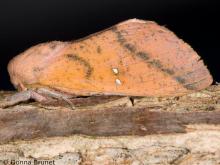Butterflies and Moths
Media

Species Types
Scientific Name
Syssphinx bicolor (syn. Sphingicampa bicolor)
Description
Honey locust moths are gray in spring and increasingly yellow, tan, or rusty later as the season progresses. The hindwings are typically rose-colored.
Media

Species Types
Scientific Name
More than 12,000 species in North America north of Mexico
Description
Learn about moths as a group. What makes a moth a moth? How are moths different from butterflies? What are the major groups of moths?
Media

Species Types
Scientific Name
More than 700 species in North America north of Mexico
Description
Learn about butterflies and skippers as a group. What makes a butterfly a butterfly? How are they different from moths? What are the major groups of butterflies?
Media

Species Types
Scientific Name
Junonia coenia
Description
The common buckeye is one of Missouri’s prettiest butterflies, but it doesn’t overwinter here. Instead, migrants arrive in late spring and early summer.
See Also


Media

Species Types
Scientific Name
About 1,500 species in North America north of Mexico
Description
Adult caddisflies are mothlike. Their larvae are aquatic and build portable, protective cases out of local materials, including grains of sand, bits of leaves and twigs, and other debris.
Media

Species Types
Scientific Name
Corydalus cornutus
Description
Adult eastern dobsonflies are huge and mothlike, with large wings and a weak, fluttery flight. The fiercely predaceous aquatic larvae, called hellgrammites, are well-known to anglers, who often use them as bait.
About Butterflies and Moths in Missouri
Butterflies, skippers, and moths belong to an insect order called the Lepidoptera — the "scale-winged" insects. These living jewels have tiny, overlapping scales that cover their wings like shingles. The scales, whether muted or colorful, seem dusty if they rub off on your fingers. Many butterflies and moths are associated with particular types of food plants, which their caterpillars must eat in order to survive.





















